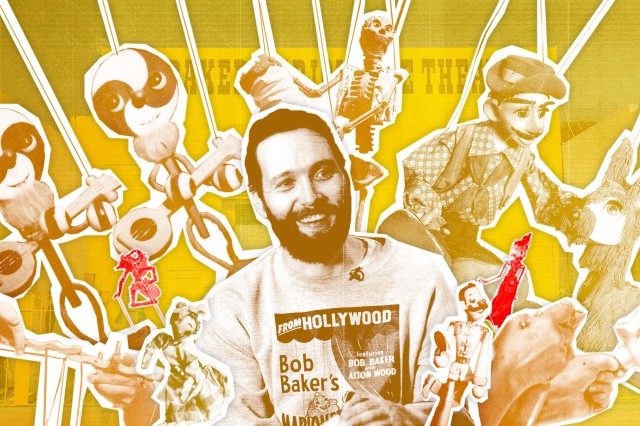
STORY
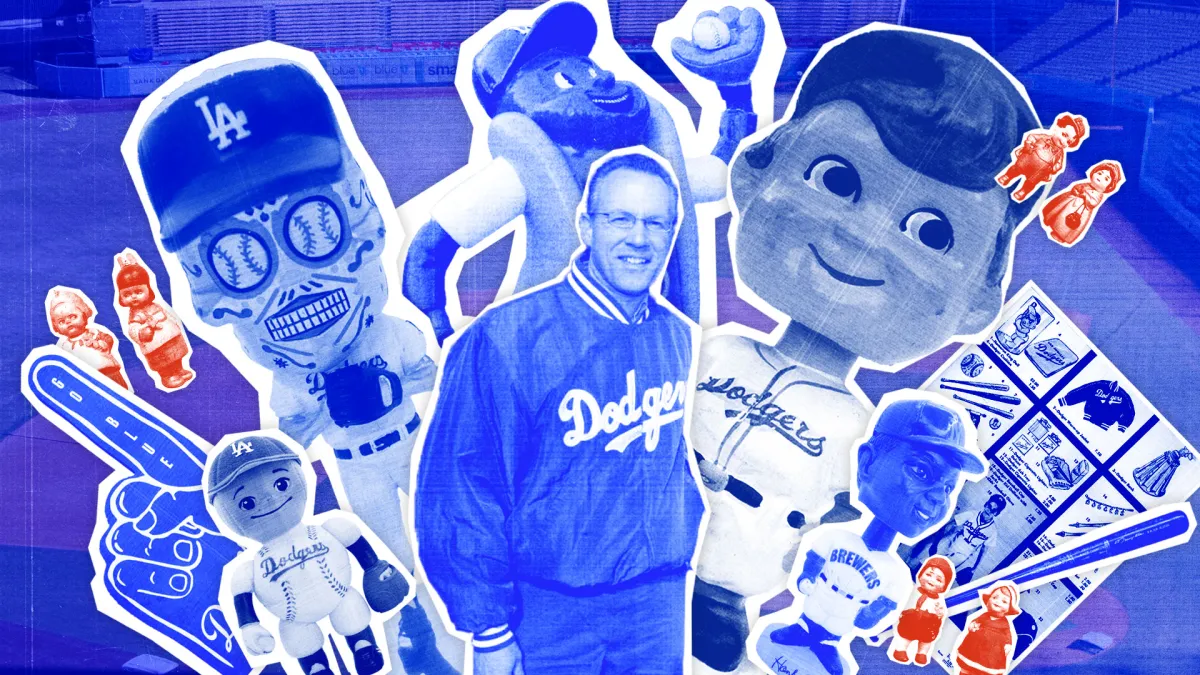
Published September 14, 2023
“The most important thing about the bobblehead are the emotions…let’s say you make a bobblehead and you want to salute Fernando Valenzuela from 1981, suddenly you just don't have a doll–you have a time machine.”
In Los Angeles, there are Dodger fans and Dodger fanatics—and then, there’s Mark Langill. For the past 20 years, Mark has served as the official team historian of the Los Angeles Dodgers. Mark’s journey from being a baseball-obsessed youth growing up in South Pasadena, California, to covering sports for the Pasadena Star-News, to eventually holding the coveted position of first-ever Dodgers Team Historian has been colored by a singular theme: “I’ve never had a bad day at the ballpark.”
Drawing on his encyclopedic knowledge of all things baseball, we sat with Mark to explore the history of one of baseball’s most popular contributions to the material lexicon of modern America, the bobblehead.
Granting us access to his personal collection of bobbleheads, Mark explains the enduring popularity of these unique figurines and their special place in the hearts of Dodger fans all over the world.
“The very first time I went to a Dodger game, it was 1972, and it was July the 15th…Aisle 44, row M, seat number one. And I remember it like it was yesterday…I just love the atmosphere, I love the history, I love the stadium, hearing Vin Scully’s stories on the radio–I was just hooked.”
Click here or above to watch Mark show off some notable nodders in his collection as he explains the role of the bobblehead in the world of Dodger fandom.
The first bobbleheads (more on those later) have a history that dates back to the late 18th century, though the first baseball-specific bobbleheads debuted in Major League Baseball in 1960. These initial figurines were imported from Japan and made of papier-mâché or porcelain. Though each team’s bobblehead wore a different uniform, the featured head did not represent a particular player. In 1960, only four players—Roberto Clemente, Mickey Mantle, Roger Maris, and Willie Mays—had bobbleheads created in their individual likenesses.
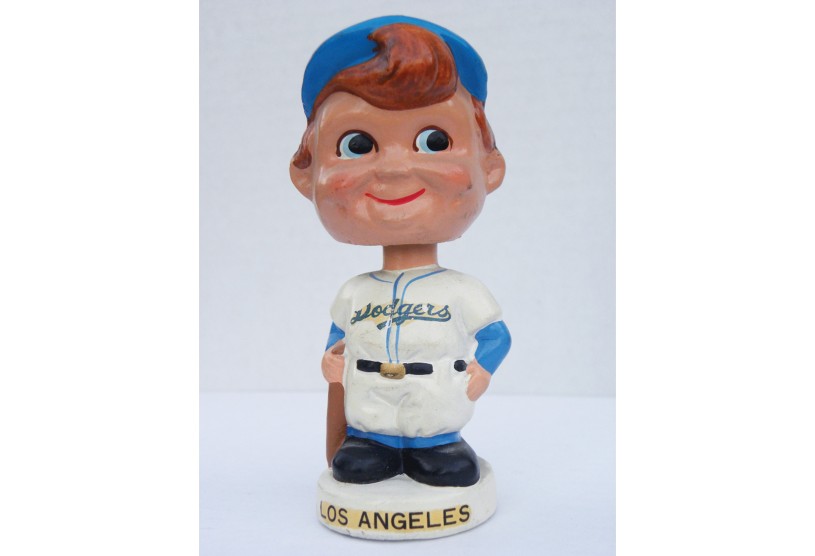
Click through the slideshow below to explore more of Mark’s collection of this unique facet of baseball history.
Milena Acosta
Another example of a generic-type bobblehead from the mid-late 1960s.
Milena Acosta
Removable decals made it possible to change the player’s team with the swap of a sticker, as long as the colors matched.
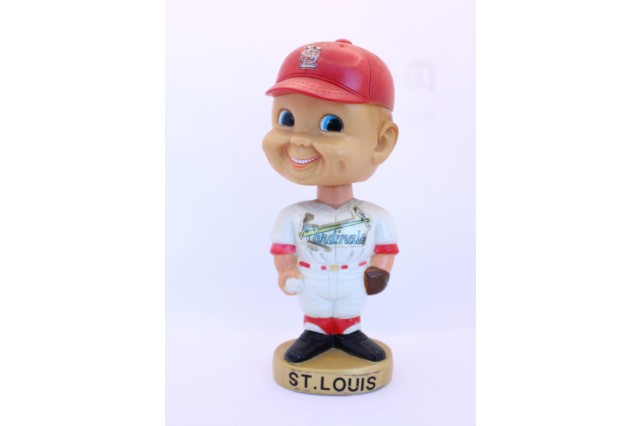
Milena Acosta
For example, a St. Louis Cardinal can easily become…
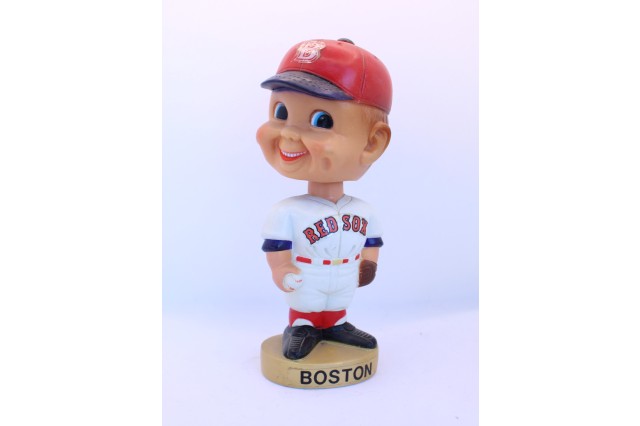
Milena Acosta
A player for the Boston Red Sox.
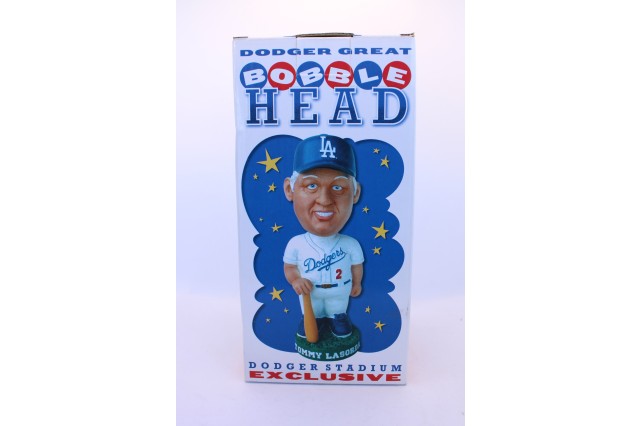
Milena Acosta
Player-specific bobbleheads were introduced to the Dodgers in 2001 with the release of the three “Dodger Great” dolls. This Tommy Lasorda doll was given out on April 4, 2001, followed by Kirk Gibson and Fernando Valenzuela bobbleheads.
Milena Acosta
Babe Ruth—a Dodger? In 1938, the Dodgers (then based in Brooklyn until 1958), brought the Great Bambino out of retirement to serve as first base coach. Notably, although 1938 marked the debut of the iconic Dodger’s cursive script, it was also the Babe’s first and last year of wearing Dodger Blue.
Milena Acosta
Although not a Dodger himself, Hank Aaron was exalted in Major League Baseball after breaking Babe Ruth’s home run record in a game against the Dodgers on April 8, 1974.
Milena Acosta
As a testament to the respect that the Dodgers paid Hank Aaron, his bobblehead was sold in 1975 at Dodger Stadium. This particular doll is one of Mark’s most cherished possessions.

Courtesy of Mark Langill
Vin Scully bobbleheads were made available as a part of Dodgers opening day in 2016. The legendary Vin Scully broadcasted for the Dodgers from 1950 to 2016.
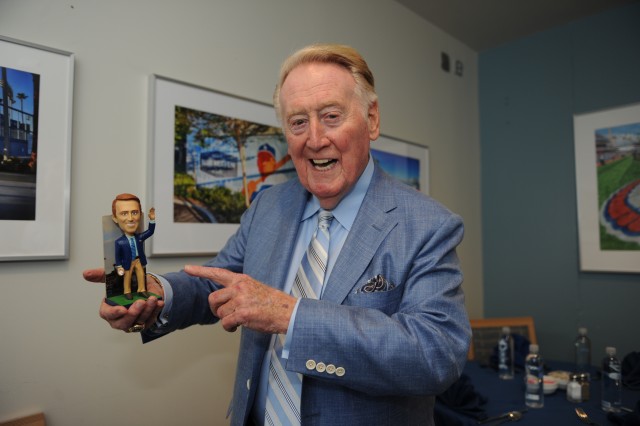
Courtesy of Mark Langill
According to Mark, “The bobblehead craze had been going on for fifteen years, and finally, we got Vinny to agree to a bobblehead…that was a big deal.”
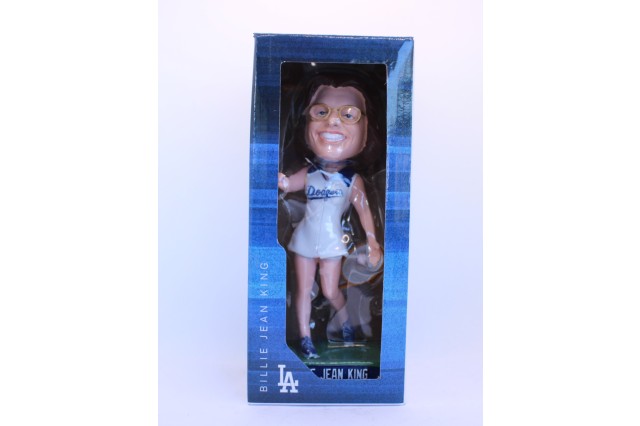
Milena Acosta
To be bobblehead-ed is not just reserved for baseball players. Billie Jean King, apart from being a tennis icon and trailblazer for women in sports, is also a part-owner of the Dodgers.
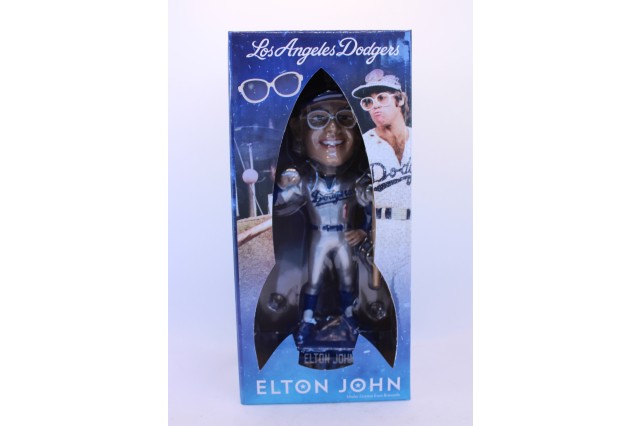
Milena Acosta
Elton John, as depicted in this bobblehead given out at Dodger Stadium, is wearing the bedazzled Dodger uniform that he wore for his October 1975 concert, which saw 55,000 fans pouring into Chavez Ravine. His friend, Billie Jean King, sang backup during the show. In 2022, Dodger Stadium once again hosted Elton John for the finale concert of his North American Farewell Tour.
1 of 1
Another example of a generic-type bobblehead from the mid-late 1960s.
Milena Acosta
Removable decals made it possible to change the player’s team with the swap of a sticker, as long as the colors matched.
Milena Acosta
For example, a St. Louis Cardinal can easily become…
Milena Acosta
A player for the Boston Red Sox.
Milena Acosta
Player-specific bobbleheads were introduced to the Dodgers in 2001 with the release of the three “Dodger Great” dolls. This Tommy Lasorda doll was given out on April 4, 2001, followed by Kirk Gibson and Fernando Valenzuela bobbleheads.
Milena Acosta
Babe Ruth—a Dodger? In 1938, the Dodgers (then based in Brooklyn until 1958), brought the Great Bambino out of retirement to serve as first base coach. Notably, although 1938 marked the debut of the iconic Dodger’s cursive script, it was also the Babe’s first and last year of wearing Dodger Blue.
Milena Acosta
Although not a Dodger himself, Hank Aaron was exalted in Major League Baseball after breaking Babe Ruth’s home run record in a game against the Dodgers on April 8, 1974.
Milena Acosta
As a testament to the respect that the Dodgers paid Hank Aaron, his bobblehead was sold in 1975 at Dodger Stadium. This particular doll is one of Mark’s most cherished possessions.
Milena Acosta
Vin Scully bobbleheads were made available as a part of Dodgers opening day in 2016. The legendary Vin Scully broadcasted for the Dodgers from 1950 to 2016.
Courtesy of Mark Langill
According to Mark, “The bobblehead craze had been going on for fifteen years, and finally, we got Vinny to agree to a bobblehead…that was a big deal.”
Courtesy of Mark Langill
To be bobblehead-ed is not just reserved for baseball players. Billie Jean King, apart from being a tennis icon and trailblazer for women in sports, is also a part-owner of the Dodgers.
Milena Acosta
Elton John, as depicted in this bobblehead given out at Dodger Stadium, is wearing the bedazzled Dodger uniform that he wore for his October 1975 concert, which saw 55,000 fans pouring into Chavez Ravine. His friend, Billie Jean King, sang backup during the show. In 2022, Dodger Stadium once again hosted Elton John for the finale concert of his North American Farewell Tour.
Milena Acosta
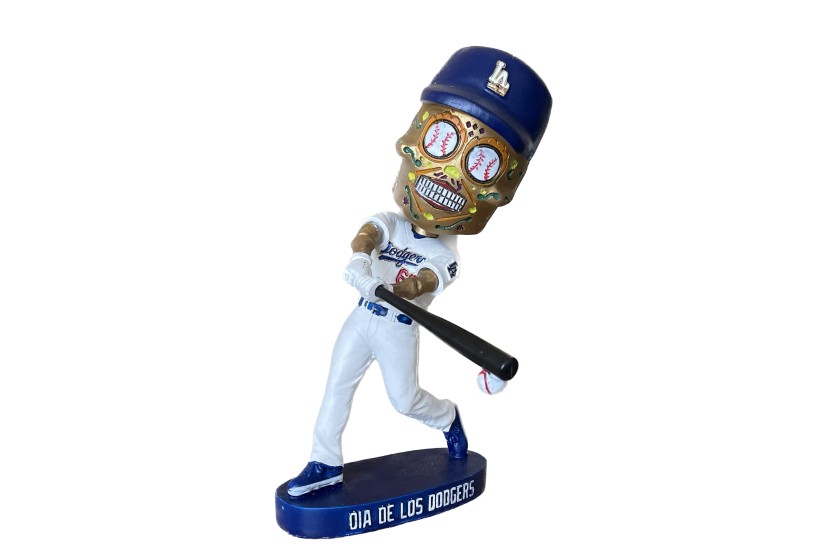
Dodgers fandom has a complex and indelible connection to the Latino community in Los Angeles. From the eminent domain takeover of the Chavez Ravine neighborhoods for the construction of Dodger Stadium in the 1950s to the explosion of Fernandomania in the 1980s—Dodger Stadium has etched itself into the cultural fabric of Latino L.A. In September of 2022, the Dodgers paid homage to their devoted Latino fanbase by hosting Dia De Los Dodgers, a Day of the Dead-themed tribute to honor beloved family members and friends. A special bobblehead was created for this event, evoking the design of a traditional Mexican calavera, or skull motif, typically employed in Day of the Dead celebrations.
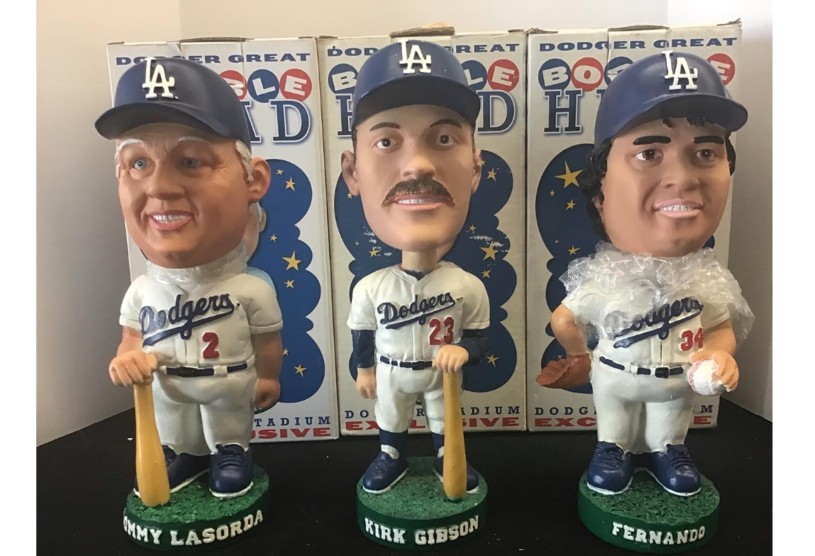
One of the most pivotal occurrences that contributed to the surge of Latinos in L.A. becoming Dodger fans was the arrival of a Mexican left-handed pitcher in 1980 named Fernando Valenzuela. Fernando bookended his 1981 season by shutting out the Houston Astros on opening day and winning the World Series at season’s end. He subsequently became the first player to win both the National League Rookie of the Year and Cy Young Awards in the same year.
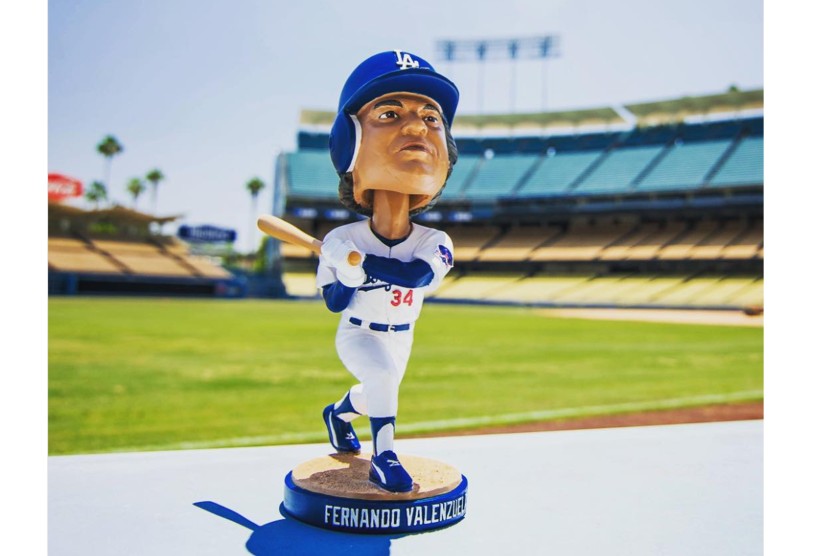
The ensuing phenomenon became known as Fernandomania, and according to the Dodger’s Spanish language broadcaster of 63 years, Jaime Jarrín, “He created more baseball fans, and Dodger fans, than any other player. Thanks to this kid, people fell in love with baseball. Especially within the Mexican community.” (quoted from mlb.com)
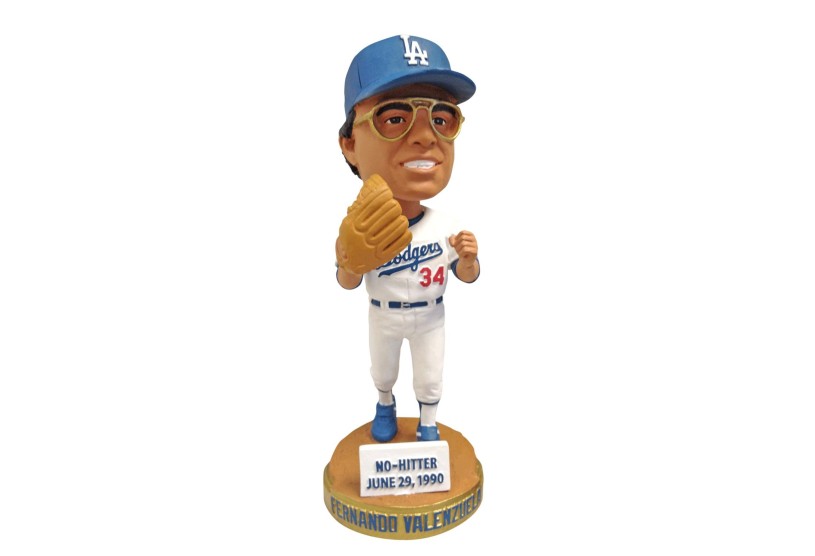
“The most important thing for the Dodger bobbleheads—it keeps improving…You want it to be better and better. You want that likeness to be better, you even want the artwork on the box to be better and more exciting.”
To what does Mark Langill, Dodgers Team Historian, attribute the enduring popularity of bobbleheads? “The era of personalization,” explains Mark. “You can get all the historical detail…There are so many possibilities for the bobblehead.” A far cry from the generic bobbleheads of yesteryear, the ability of today's figurines to capture moments in baseball history with snapshot-like specificity ensures their popularity with collectors and casual fans alike. Scroll through the slideshow below to witness Dodger history immortalized through bobbleheads.
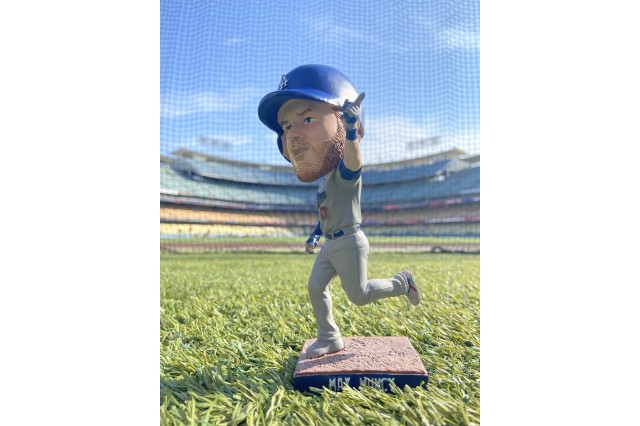
During a 2019 game against the San Francisco Giants, Dodgers slugger Max Muncy hit a home run out of the Bay Area’s Oracle Park and into the ocean off Giants pitcher Madison Bumgarner. The two had words as Muncy rounded the bases, with Muncy yelling at Bumgarner to, “Go get it out of the ocean.” Muncy’s triumphant rounding of the bases and triumphant declaration were immortalized in this collectible bobblehead.
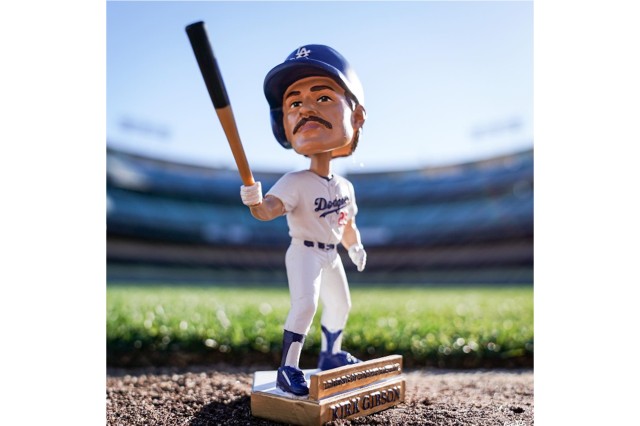
This bobblehead of Kirk Gibson immortalizes his famous 1988 World Series Game 1 at-bat against the Oakland Athletics. Gibson hit a walk-off home run in the bottom of the ninth that secured their 1-0 victory over the A’s. Gibson had been nearly hobbled by injuries and was visibly discomforted by injury during his plate appearance. After Kirk launched his home run into right field, Vin Scully let the jubilation of the crowd speak for itself for one minute and nine seconds, then announced one of the most famous lines in baseball history: “In a year that has been so improbable, the impossible has happened.”
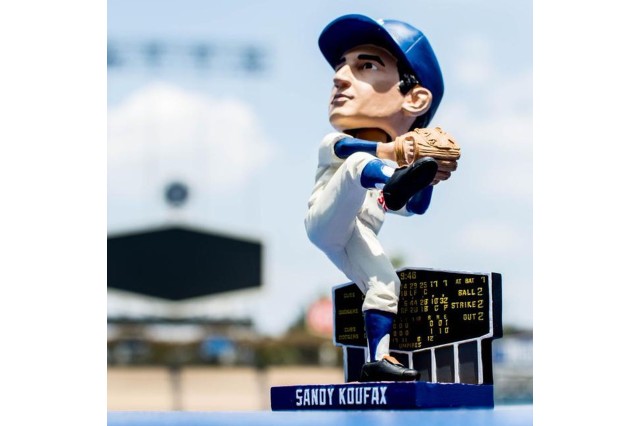
In 2015, the Dodgers released a special Sandy Koufax bobblehead to commemorate the perfect game he threw against the Chicago Cubs on September 9, 1965. Koufax’s signature windup and the miniature scoreboard all faithfully depict the moment right before he threw his final strike of the night, a perfect game heralded by Vin Scully’s famous call, “Swung on and missed!”
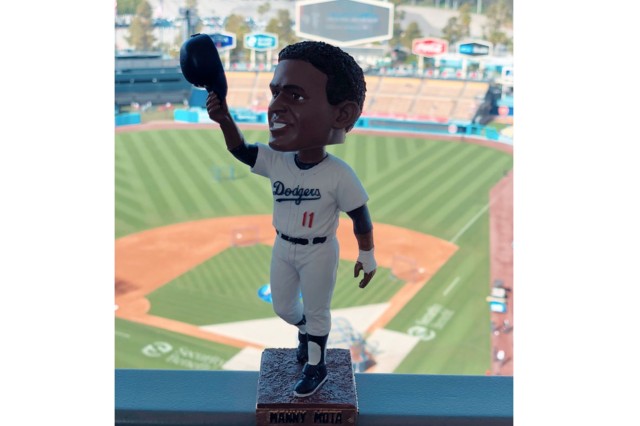
@andrewbansalofficial, Instagram
This 2023 bobblehead depicts Manny Mota as he tips his cap after hitting his 145th pinch hit to break the all-time record on September 2nd, 1979. Mark explains, “In that moment, you can photo match the bobblehead pose to something that actually happened in history, that's the real goal.”
1 of 1
During a 2019 game against the San Francisco Giants, Dodgers slugger Max Muncy hit a home run out of the Bay Area’s Oracle Park and into the ocean off Giants pitcher Madison Bumgarner. The two had words as Muncy rounded the bases, with Muncy yelling at Bumgarner to, “Go get it out of the ocean.” Muncy’s triumphant rounding of the bases and triumphant declaration were immortalized in this collectible bobblehead.
This bobblehead of Kirk Gibson immortalizes his famous 1988 World Series Game 1 at-bat against the Oakland Athletics. Gibson hit a walk-off home run in the bottom of the ninth that secured their 1-0 victory over the A’s. Gibson had been nearly hobbled by injuries and was visibly discomforted by injury during his plate appearance. After Kirk launched his home run into right field, Vin Scully let the jubilation of the crowd speak for itself for one minute and nine seconds, then announced one of the most famous lines in baseball history: “In a year that has been so improbable, the impossible has happened.”
In 2015, the Dodgers released a special Sandy Koufax bobblehead to commemorate the perfect game he threw against the Chicago Cubs on September 9, 1965. Koufax’s signature windup and the miniature scoreboard all faithfully depict the moment right before he threw his final strike of the night, a perfect game heralded by Vin Scully’s famous call, “Swung on and missed!”
This 2023 bobblehead depicts Manny Mota as he tips his cap after hitting his 145th pinch hit to break the all-time record on September 2nd, 1979. Mark explains, “In that moment, you can photo match the bobblehead pose to something that actually happened in history, that's the real goal.”
Mark emphasizes that he is excited about the future of bobbleheads. “You have to keep up with technology, you have to keep up with whatever people are collecting, and that's the great thing.” Although the popularity of bobbleheads waxed, waned, and waxed again since the 1960s and are now some of the most sought-after baseball collectibles, the famous Dodger script has been applied to myriad other souvenirs throughout the years. Click through the slideshow below to see a selection of the Dodger’s past souvenirs.
Courtesy of Mark Langill
This official mail-order catalog shows a wide offering of novelty souvenirs from 1959.
Courtesy of Mark Langill
From cigarette lighters to miniature baseball bats—notice the variety of souvenir items offered in this 1959 mail-order catalog.
Courtesy of Mark Langill
A further assortment of souvenir items offered in 1959.
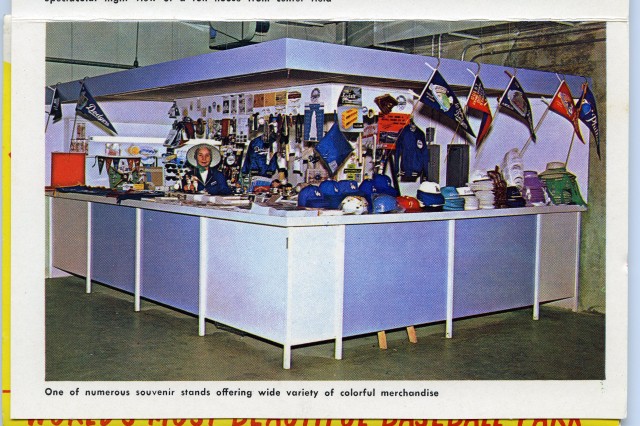
Courtesy of Mark Langill
This archival photo from 1962 shows one of the several souvenir stands inside Dodger Stadium.
Milena Acosta
This plastic squirt-toy bear was sold at Dodger Stadium in the 1980s.
Milena Acosta
This adorable “ball boy” was sold by the Dodgers in the early 1960s.
1 of 1
This official mail-order catalog shows a wide offering of novelty souvenirs from 1959.
Courtesy of Mark Langill
From cigarette lighters to miniature baseball bats—notice the variety of souvenir items offered in this 1959 mail-order catalog.
Courtesy of Mark Langill
A further assortment of souvenir items offered in 1959.
Courtesy of Mark Langill
This archival photo from 1962 shows one of the several souvenir stands inside Dodger Stadium.
Courtesy of Mark Langill
This plastic squirt-toy bear was sold at Dodger Stadium in the 1980s.
Milena Acosta
This adorable “ball boy” was sold by the Dodgers in the early 1960s.
Milena Acosta
Before bobbleheads were a mainstay in the Major Leagues, and during the first time the very sport of baseball swept the nation at the height of the American Civil War, a small factory town in Germany was turning out miniature dolls with strings attached to articulated heads. These “nodders,” or “knotters,” would be the material progenitors to modern-day bobbleheads. Explore the slideshow below to view some of the nodders in the care of the Museum’s collections.
Natural History Museums of Los Angeles County, History Department (Material Culture)
These bisque dolls were made between the 1920s and 1930s in Germany by Hertwig & Co., a porcelain manufacturer founded in 1864 in the municipality of Katzhütte. These early nodders usually came in pairs, as with this Dutch boy and girl. The heads are attached to the body only by way of a knotted string that runs through the body and is affixed to an opening in the back of the doll by a knot. Pulling on the exposed knot would cause the head to nod.
Natural History Museums of Los Angeles County, History Department (Material Culture)
The knots (hence “knotters”) which cause the head to swivel and nod are visible at the tops and bottoms of the figures. These dolls stand 3” tall.
Natural History Museums of Los Angeles County, History Department (Material Culture)
Although these bisque figures were produced by Hertwig & Co. in the early 20th century, the first mention of figurines with nodding heads appeared in continental Europe in the 1780s. Elaborately painted plaster nodding-head figures were imported to Europe from China to satisfy the taste of wealthy European courtiers for “exotic” Asian decorations.
Natural History Museums of Los Angeles County, History Department (Material Culture)
Nodders depicting a Native American boy and girl, made by Hertwig & Co. in the 1930s.
1 of 1
These bisque dolls were made between the 1920s and 1930s in Germany by Hertwig & Co., a porcelain manufacturer founded in 1864 in the municipality of Katzhütte. These early nodders usually came in pairs, as with this Dutch boy and girl. The heads are attached to the body only by way of a knotted string that runs through the body and is affixed to an opening in the back of the doll by a knot. Pulling on the exposed knot would cause the head to nod.
Natural History Museums of Los Angeles County, History Department (Material Culture)
The knots (hence “knotters”) which cause the head to swivel and nod are visible at the tops and bottoms of the figures. These dolls stand 3” tall.
Natural History Museums of Los Angeles County, History Department (Material Culture)
Although these bisque figures were produced by Hertwig & Co. in the early 20th century, the first mention of figurines with nodding heads appeared in continental Europe in the 1780s. Elaborately painted plaster nodding-head figures were imported to Europe from China to satisfy the taste of wealthy European courtiers for “exotic” Asian decorations.
Natural History Museums of Los Angeles County, History Department (Material Culture)
Nodders depicting a Native American boy and girl, made by Hertwig & Co. in the 1930s.
Natural History Museums of Los Angeles County, History Department (Material Culture)
The L.A. at Play story is not complete without you! Share your creature, doll, bobblehead, or figurine story and follow the stories of the makers who are contributing to some of L.A.'s most iconic fandoms–tag us @NHMLA with #LAatPlay.
Explore More Stories of Dolls, & Figurines